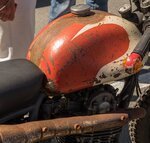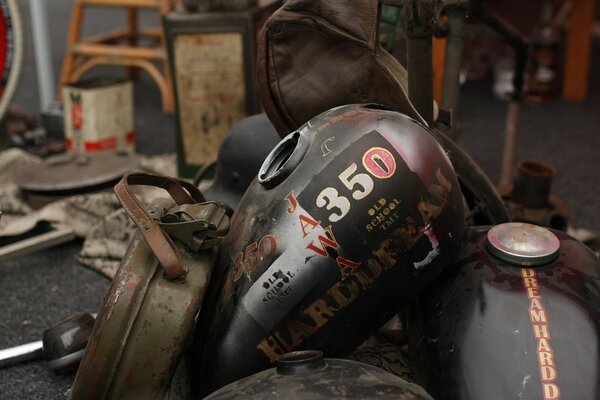A leakage in the bike gas tank is not difficult to repair if you know how to fix a leak in a motorcycle gas tank. Your motorcycle’s gas tank is a thin piece of metal, and even a slight impact can puncture it.
At times, some design imperfections and manufacturing issues can cause a gas tank to tear up. If you are looking to fix a leak in a motorcycle gas tank, you need to get to it right away because it may catch fire and cause serious injuries.
You can visit your mechanic and fix it or buy a new tank altogether. The costs will be very high, and it would be a better option to fix it independently.
So, let’s get started!
What Causes a Fuel Tank to Leak?

Fuel tank leaks are common issues that motor bikers have to deal with. One of these leaks’ primary causes is rotting the tank once it gets old. At times a high impact can cause leaks if you have dropped your bike or met an accident. You need to start thinking about how to fix a leak in a motorcycle gas tank.
Some leaks occur because there is a small hole in your fuel tank, and if that is the case, the rapier work is not going to be an uphill task. You can observe or experience leakage, especially with a continuous smell of fuel coming from your bike. Your fuel lines and their fitting might also cause leakage as they wear and tear over time.
Can a Leaking Gas Tank be Repaired?

A leaking motorcycle gas tank might seem an alarming situation. But in most cases, you can conveniently repair your gas tank with minimal effort, so you won’t have to deal with many issues in how to fix a leak in a motorcycle gas tank. But before any repairs, make sure to access the tank and find the exact source of the leakage.
You must clean the area around it and then begin with the repair work. For a simple but highly effective and efficient fix, you need to cover the leakage with epoxy putty. Over the years, these tanks can degrade, and their cause can be poor maintenance and bad weather conditions or road impacts of being exposed to moisture frequently.
Any of those pinholes caused by rusting can be repaired with epoxy for the time being. But you need to repair it by a professional or replace the tank with a new one for the larger holes.
How to Fix a Leak in a Motorcycle Gas Tank?
Want to fix your motorcycle gas tank leak right now? Here’s what you need to know. Your motorcycle’s gas tank is of thin materials and not that robust as other parts of your bike. The tank is either aluminum or steel and can easily puncture and get dents. Over time, it can get rusted too.
There are some steps involved in the issue of how to fix a leak in a motorcycle gas tank. The step-by-step process that you need to follow is here:
Step 1 – Drain your tank

For a safe repair, you need to make sure your gas tank is empty. Every last drop of fuel needs to come out of your tank, so keep it a safe repair. If that is not the case, there may be a serious fire hazard.
It’s an important step that you need to consider because you don’t want the fuel to catch fire when you are welding your tank. Turn the fuel line off and start draining the fuel into a safe container. In case of a spill, you can always use something that can quickly absorb the spill. Kitty litter can work well in such a scenario.
Step 2 – Removing the tank

Gas tanks come in all shapes and sizes. But they all behave in the same manner. Therefore, certain parts or components are there in all tanks. You can consult the owner’s manual of your bike to see what parts you need to deal with.
You will only need a simple adjustable wrench to remove the tank by unbolting it. Also, you will need to have a good glance under your tank and see what type of mounting bolts are there. In most cases, the bolt is right in the middle under the tank.
In some bikes, you will have to get rid of the seat for removing the tank. The manual will have all the instructions, so don’t forget to consult that.
Step 3 – Preparing the tank for repair
Begin by taking the fuel cap off and air out those flammable fumes. Just make sure that the gas is entirely out of the tank. If your tank is old or you haven’t maintained it properly, then rust will be very prominent inside the tank.
You can use a flashlight to peek inside your tank. You need to remove the rust before you start applying the chemicals mechanically. Just take your time and see what’s on the inside of your tank and how bad it is.
For the rusted outer parts, you can use a couple of quarts of acetone as well as ball bearings, bolts, and nuts. Acetone is a kind of thinner and is mainly in nail paint removers. Rotate and shake your tank in a way to make sure the ball bearings or bolts make contact with all the corners inside your tank.
It will know the rust and create scratches for the epoxy to hold on to later. Some tanks are more significant and tougher to do this. Just take your time in this step because it is laying the foundation.
Step 4 – Sealing the tank
For this part, you will need epoxy and use it according to the directions that come with it. There are a variety of options that you consider for this purpose. Just prepare the mix and pour it into your tank.
Place a cling wrap piece right over the fill hole and ensure its security. Now it’s time to slosh the epoxy around. Make sure you give it time for about 24 hours to cure. After that, you can fix it back and fill it with gas.
Why is My Motorcycle Leaking Gas? 5 Possible Reasons
Thinking about why you use your motorcycle leaking gas? There might be different reasons that your motorcycle is leaking gas. But in most cases, these are the 5 possible reasons for this issue.
- Your fuel petcock or fuel valve might be the reason for the leakage. It can leak anytime, and it is not just that you have turned the gas flow on. The cause here is a faulty gasket or O-ring that is connecting the petcock with the gas tank below.
- The carburetor is another place to cause a leak because the gasket on it has worn out. The bowl on this component holds the gas to get sucked into the engine. When the gasket is not doing its job, your fuel will sit there idle.
- There is a drain plug at the bottom of the carburetor bowl, and it is also prone to leakage, especially if it gets loose over time. Here the leakage is between the foul line and the carburetor.
- Rusting within the gas tank can also cause holes and initiate leaks. Rusting can be due to poor maintenance or wear and tear.
- Last but not least is the fuel injector, and leakage might be caused by loose-fitting. Make sure to check all the connections and fitting properly during your repairs and ensure that everything is right in its place to prevent any leakages.
What Can I Use to Seal a Gas Tank Leak?
Thinking about what can you use to seal your leaking gas tank? Epoxy is an excellent answer to this question because it will get the job done in no time. But make sure you are only using it for repairing small holes. For those bigger holes, it would be better to pay a visit to your mechanic.
There are different fuel tank repairing kits available on the market to repair diesel and gasoline fuel tank leaks permanently. Some of them can repair within half an hour.
These kits are for repairing pinholes, hairline cracks, rust outs, hairline cracks, as well as bigger holes that are up to half an inch in diameter. They are entirely resistant to kerosene, gasoline, disposal, and water.
Can You Weld a Gas Tank Hole?

Yes, you can weld a gas tank but make sure you have emptied your gas tank, and its inside is arid. Otherwise, there is a fire hazard. You can weld your gas tank and then sand it to get rid of any pinholes, rust, or grime.
Just paint the tank and allow it to adhere. You can also use a brake cleaner and a terry cloth towel for cleaning and wiping the sanded region of your tank.
Common Problems
The most common problem associated with this repair work is that you don’t have to rush through the entire process. Thoroughly check the tank for any leakages. Also, dry out the underneath area to identify the exact location of the leak.
At times the leak is not occurring in front of the tank. The source of the problem is somewhere else. Also, when repairing, make sure to tighten up everything. Don’t leave anything loose, or it will cause the fuel to leak.
FAQ
Will JB Weld seal a gas tank?
Yes, JB Weld is one of the top choices for you to use to seal your gas tank. It is effective for rusting and corrosion as well.
What is the best sealant for gasoline?
The best sealant for gasoline is Permatex PermaShield which uses a fuel-resistant adhesive and gasket dressing made of polyester urethane.
Can you drive a motorcycle that is leaking gas?
Yes, you can drive a leaking gas motorcycle, but it’s not advisable because leakages can catch fire and cause injuries.
How do you repair a hole in an aluminum gas tank?
You can fix it using the JB Weld sealant that is highly effective for aluminum and steel gas tanks.
Conclusion
Want to fix your leaking motorcycle gas tank? You need to make sure that you go through the process carefully, without any rush.
Use quality sealants and follow the instructions when removing the tank and fixing it back. To avoid any leaks in the future, take care of your bike. Do the timely repairs, and everything will keep running smoothly for years to come. This is everything about how to fix a leak in a motorcycle gas tank.

